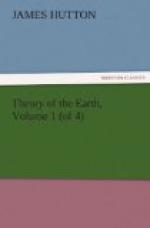Mr Hall having had occasion to examine the Pease and Tour burns, in planning and superintending the great improvement of the post road upon Sir James Hall’s estate while Sir James was abroad, he informed me that the junction of the schistus and sand-stone strata was to be found in the Tour burn. Professor Playfair and I had been intending a visit to Sir James Hall at Dunglass; and this was a motive, not so much to hasten our visit, as to chose the most proper time for a mineral expedition both upon the hills and along the sea shore.
It was late in the spring 1788 when Sir James left town, and Mr Playfair and I went to Dunglass about the beginning of June. We had exceeding favourable weather during the most part of our expedition; and I now propose to give an account of the result of our observations.
Dunglass burn is the boundary between the counties of East Lothian and Berwickshire; and it is almost the boundary between the vertical and horizontal strata. To the north-west of this burn and beautiful dean are situated the coal, lime-stone, marl, and sand-stone strata; they are found stretching away along the shore in a very horizontal direction for some time, but become more and more inclined as they approach the schistus of which the hills of Lammermuir to the south are composed.
Though the boundary between the two things here in question be easily perceivable from the nature of the country at the first inspection, by the rising of the hills, yet this does not lead one precisely to the junction; and in the extensive common boundary of those two things, the junction itself is only to be perceived in few places, where the rock is washed bare by the rivers or the sea, and where this junction is exposed naked to our view. The sea is here wearing away the coast; and the bank, about 200 feet high, is gradually falling down, making in some places a steep declivity, in others a perpendicular cliff. St Abb’s Head and Fast Castle are head lands projecting into the sea, and are the bulwarks of this shore, which is embayed to the westward, where the sea preys upon the horizontal strata. The solid strata are every where exposed either in the cliff or on the shore; we were therefore certain of meeting with the junction in going from Dunglass to Fast Castle, which is upon the schistus. But this journey can only be made by sea; and we first set out to examine the junction in the Tour and Pease burns, where we had been informed it was to be found.
In the bottom of those rivulets the sand-stone and marly strata appear pretty much inclined, rising towards the schistus country. The two burns unite before they come to the shore; and it is about midway between this junction and the bridges which are thrown over those two hollows, that the junction is to be found.
The schistus strata here approach towards vertical; and the sand-stone strata are greatly inclined. But this inclination of those two different strata are in opposite directions; neither does the horizontal section of those two different strata run parallel to the junction; that is to say, the intersection of those two different strata is a line inclined to the horizon.




